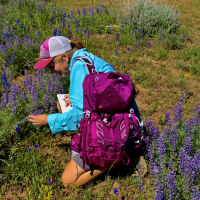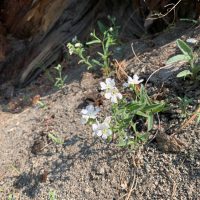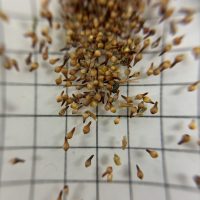Rare Care Monitoring Weekend 2025
The weekend of June 5th-8th, 14 Rare Care volunteers traveled to the Okanogan Highlands in the Tonasket Ranger District of the Colville National Forest and surrounding Bureau of Land Management land for our annual Monitoring Weekend. Almost every person found and surveyed our target species for the weekend – northern blue-eyed grass (Sisyrinchium septentrionale). Six of the ten populations surveyed were larger in size than reported in the 90’s, some 10-100 times larger.
Notes from the Field
We expected this survey season to be difficult with a hot and dry spring and summer causing shorter and earlier windows for finding rare plants. However, our volunteers, ever dedicated to the cause, rose to the challenge.
Sarah Stolar knew success would require arduous effort to reach a fern-leaf goldthread (Coptis aspleniifolia) population after Rare Care’s last three attempts couldn’t reach the location.
Meet Rare Care’s 2025 Field Technician
Jacob Maki was Rare Care’s 2025 seasonal field technician. Maki started as a volunteer monitor with Rare Care in 2021. After graduating with a degree in plant biology from the University of Washington last year, he decided to take a stab at a full season of Rare Care.
Assisting with seed collections, outplantings, and monitoring, he traveled across the state from the Olympic Mountains to the basalt cliffs of the Columbia River, and even to channeled scablands in Odessa, WA.
2025 Plant Conservation Leadership Summit
In August, Rare Care Program Manager Wendy Gibble attended the Plant Conservation Leadership Summit at the Atlanta Botanic Gardens. Over 100 leaders from 64 botanic gardens and affiliated organizations across the US convened to strategize how to advance plant conservation objectives in this new environment of severely reduced federal funding. Nearly all organizations have been impacted by the termination of federal grants and/or the lack of new funding opportunities.
Read moreVolunteer Spotlight: Cyndy Smith-Kuebel

Cyndy Smith-Kuebel was indoctrinated into the outdoor life from day one. Growing up in Western WA, her father found Cyndy an eager student of scientific plant names and quizzed her up and down trails as they hiked in the Cascade Mountains. This sparked a life-long interest in botany and plant ecology that she pursued at the US Forest Service Cle Elum Ranger District.
Read moreShowy Stickseed Conservation Efforts

Showy stickseed (Hackelia venusta) is one of Washington’s most imperiled plants. Its only known population occurs in sandy soils on steep, sliding slopes in Tumwater Canyon near Leavenworth, WA. With only a few hundred individuals left, it is at significant risk of extinction without tenacious attention and stewardship. To that end, Rare Care recently completed a recovery project funded by US Fish & Wildlife Service (USFWS) to (1) introduce plants at a new site and (2) install permanent monitoring plots in the natural population.
Read moreCreating a Conservation Collection

Springtime has us thinking about the magic of seeds. They hold all the material needed to start a new plant—DNA, food and the start of new leaves and a root—all within a convenient, compact package. For many species, their durable coat offers them protection from the elements while they await suitable conditions to set down roots. Some seeds can withstand fire, icy winters, or the highly acidic environment of an animal’s digestive system.
Read morePartner Focus – Columbia Land Trust

Rare Care is fortunate to partner with several land trusts in the state to conserve rare plants. One such organization is the Columbia Land Trust, who works across five ecosystems from the mouth of the Columbia River to approximately 200 miles inland and 50 miles north and south of the river in Washington and Oregon. We reached out to Nate Ulrich, Conservation Manager, to find out more about their work.
Read moreOn the Hunt for Spalding’s Catchfly
Out among the undulating biscuit and swale topography of the sagebrush-steppe in east-central Washington lives Spalding’s catchfly (Silene spaldingii). The basalt studded landscape feels vast and open under the blue skies of summer. For three weeks in August of 2023, you could find Allie Howell and I hiking between hundreds of patches of Spalding’s catchfly scattered over 50 square miles. Our task was to gather an updated population count after the devastating Whitney fire in 2020 that swept through a large section of the plant’s range in east-central Washington.
Read more